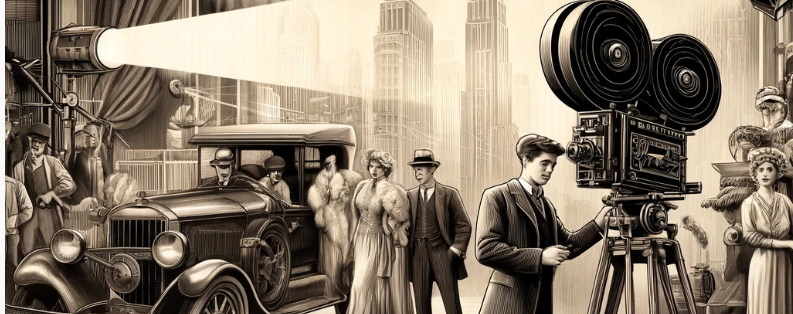| Listen to our audio presentation: The Most Famous Films in History |
The history of cinema is a fascinating journey of innovation and transformation, spanning over a century of rapid technological progress and cultural shifts. From the first silent films to the modern digital theaters, the film industry has continuously evolved, influencing and reflecting society along the way.
The Silent Era: Storytelling Without Words
The genesis of cinema can be traced back to the late 19th century when the first motion picture cameras were developed. The earliest films were short, silent clips, often just a few minutes long, showcasing everyday scenes, simple actions, or staged events. The lack of sound did not hinder the expressive power of these films; instead, it necessitated an emphasis on visual storytelling, exaggerated expressions, and mime-like acting to convey the plot.
Silent film icons like Charlie Chaplin, Buster Keaton, and Mary Pickford became household names, mastering the art of conveying emotion and comedy through physical actions. These films were often accompanied by live music to enhance the viewing experience, creating a communal atmosphere that was uniquely engaging.
The Introduction of Sound: The Birth of “Talkies”
The transition from silent films to “talkies” began with the development of synchronized sound technology. The 1927 release of “The Jazz Singer,” the first feature-length film to include synchronized dialogue sequences, marked a historical shift in the film industry. This innovation didn’t just change how films were made; it revolutionized what they could express, bringing new genres like musicals to the forefront and expanding the narrative possibilities.
However, the transition was not seamless. The introduction of sound required expensive new equipment and soundproofing measures, leading to financial upheaval and the end of many silent film stars’ careers who couldn’t adapt to the new format.
Technicolor Triumphs: The Rise of Color Films
While early films were either black and white or hand-colored in a labor-intensive process, the advent of Technicolor in the 1930s brought vibrant color to the silver screen. This technology, first used in mainstream cinema with films like “The Wizard of Oz” and “Gone with the Wind” in 1939, added a new dimension to cinematic storytelling. Color films quickly became synonymous with high-quality production and spectacle, although black and white remained a stylistic choice for many filmmakers.
Modern Cinema: Digital Technology and Beyond
The latter half of the 20th century and the early 21st century have seen digital technologies take center stage. The development of computer-generated imagery (CGI) has allowed filmmakers to create detailed, realistic scenes that would be impossible to capture on film. Movies like “Jurassic Park” and “Avatar” showcased the potential of digital effects, setting new standards for visual spectacle.
The transition to digital cinema has also transformed how films are distributed and displayed. Digital projectors, 3D cinema, and IMAX theaters have enhanced the visual clarity and immersive experience of movie-going. Moreover, the rise of streaming services has changed how audiences access and consume films, challenging traditional theater models but also providing filmmakers with more platforms to showcase their work.
The Contemporary Scene: A Diverse Landscape
Today, cinema is more diverse than ever, both in terms of content and in the way it is consumed. Independent films and international cinema have gained prominence, powered by digital distribution channels that bypass traditional barriers to entry. At the same time, blockbuster films continue to draw large audiences, demonstrating cinema’s ongoing ability to offer shared experiences on a grand scale.
Understanding the evolution of cinema from silent films to the digital age illustrates not only technological advancements but also changes in audience expectations and cultural norms. Each phase in the development of film technology has expanded the horizons of storytelling and visual artistry, reflecting and shaping societal trends and values. As we look to the future, the film industry’s ability to adapt and innovate will continue to be crucial in its enduring appeal and cultural significance.

